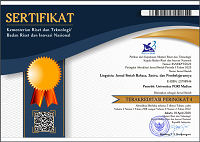The implementation of online learning in teaching english for athlete students
Abstract
Keywords
Full Text:
PDFReferences
Henderson, M., N. Selwyn, and R. Aston. 2017. “What Works and Why? Student Perceptions of ‘Useful’ Digital Technology in University Teaching and Learning.” Studies in Higher Education 42 (8): 1567–79.
Helsper, E. J., and R. Eynon. 2010. “Digital Natives: Where Is the Evidence?” British Educational Research Journal 36 (3): 503–20.
Lantz-Andersson, A., S. Vigmo, and R. Bowen. 2013. “Crossing Boundaries in Facebook: Students’ Framing of Language Learning Activities as Extended Spaces.” Computer-Supported Collaborative Learning 8: 293–312.
Tess, P. A. 2013. “The Role of Social Media in Higher Education Classes (Real and Virtual) – A Literature Review.” Computers in Human Behaviour 29: 60–68.
Manca, S., and M. Ranieri. 2016. “Facebook and the Others.
Potentials and Obstacles of Social Media for Teaching in Higher Education.” Computers & Education 95: 216–30.
Sharma, S. K., A. Joshi, and H. Sharma. 2016. “A Multi-Analytical Approach to Predict the Facebook Usage in Higher Education.” Computers in Human Behaviour 55: 340–53.
Whitaker, J., J. R. New, and R. D. Ireland. 2016. “MOOCS and the Online Delivery of Business Education What’s New? What’s Not? What Now?” Academy of Management Learning & Education 15 (2): 345–65.
Murphy, M. P. A. (2020). COVID-19 and emergency elearning: Consequences of the securitization of higher education for post-pandemic pedagogy. Contemporary Security Policy, 41(3), 492–505. https://doi.org/10.1080/13523260.2020.1761749
Viner, R. M., Russell, S. J., Croker, H., Packer, J., Ward, J.,
Stansfield, C., Mytton, O., Bonell, C., & Booy, R. (2020). School closure and management practices during coronavirus outbreaks including COVID-19: a rapid systematic review. In The Lancet Child and Adolescent Health (Vol. 4, Issue 5, pp. 397–404). Elsevier B.V. https://doi.org/10.1016/S2352-4642(20)30095-X
Daniel, S. J. (2020). Education and the COVID-19 pandemic. Prospects, 1–6. https://doi.org/10.1007/s11125-020-09464-3
O’Malley, J. M., & Pierce, L. V. (1996). Authentic assessment for English language learners: Practical approaches for teachers. Addison-Wesley Pub. Co.
Fischer, L., Hilton, J., Robinson, T. J., & Wiley, D. (2015). A Multi-institutional Study of the Impact of Open TextbookAdoption on the Learning Outcomes of Post-secondary Students.Journal of Computing in Higher Education.https://doi.org/10.1007/s12528-015-9101-x.
(4) (PDF) Blended learning: the new normal and emerging technologies. Available from: https://www.researchgate.net/publication/323200713_Blended_learning_the_new_normal_and_emerging_technologies.
Pedescleaux, J. (2010). Motivation factors as indicators of academic achievement: a comparative study of student-athletes and nonathletes academic and social motivation. Retrieved from Proquest. (3421819).
Cohen and Swerdlik, (2009) Psychology testing and assessment: An introduction to test and measurement. New York: McGraw-Hill.
Creswell, J. W. (2013). Educational research: Planning, conducting, and evaluating quantitative and qualitative research. Pearson.
Menteri Pendidikan dan Kebudayaan Republik Indonesia. (2020). Surat Edaran Nomor 3636Z/MPK.A/HK/2020 tentang pembelajaran secara daring dan bekerja dari rumah dalam rangka pencegahan penyebaran Corona Virus Disease (COVID- 19). Kementerian Pendidikan dan Kebudayaan Republik Indonesia
Crick, T., Knight, C., Watermeyer, R., & Goodall, J. (2020). The Impact of COVID-19 and “Emergency Remote Teaching” on the UK Computer Science Education Community. UKICER '20: United Kingdom & Ireland Computing Education Research Conference, 31-37. doi:10.1145/3416465.3416472
Abrami, P. C., Bernard, R. M., Bures, E. M., Borokhovski, E., & Tamim, R. M. (2011). Interaction in distance education and online learning: using evidence and theory to improve practice. Journal of Computing in Higher Education, 23(2-3), 82–103.
Selwyn, N., & Stirling, E. (2015). Social media and education … now the dust has settled. Learning, Media and Technology, 41(1), 1–5.
Veletsianos, G. (2011). Higher education scholars’ participation and practices on Twitter. Journal of Computer Assisted Learning, 28(4), 336–349.
Junco, R., Heiberger, G., & Loken, E. (2010). The effect of Twitter on college student engagement and grades. Journal of Computer Assisted Learning, 27(2), 119–132.
Article Metrics
Abstract has been read : 562 timesPDF file viewed/downloaded: 0 times
DOI: http://doi.org/10.25273/linguista.v5i1.9470
Refbacks
- There are currently no refbacks.
Linguista: Jurnal Ilmiah Bahasa, Sastra, dan Pembelajarannya indexed by:
View My Stats








